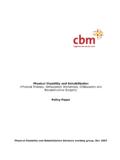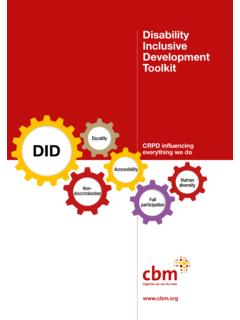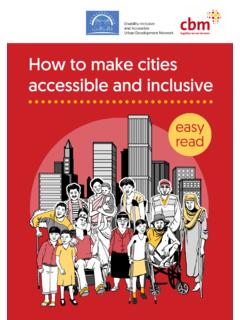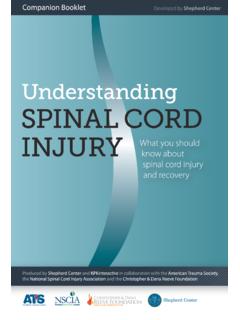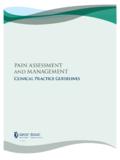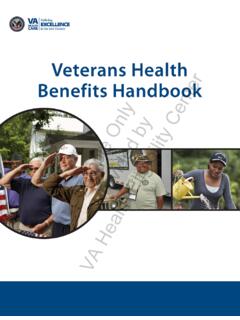Transcription of INCLUSION MADE EASY - CBM International
1 Part AINCLUSION made easy CBMA quick program guide to disability in development CBM INCLUSION made easy / I How to use this guideThis guide is divided into two parts. Part A focuses on disability-inclusive development principles and Part B focuses on disability INCLUSION across a range of development sectors or program areas. Part A provides the context and guiding principles around disability-inclusive development. It addresses the reasons why disability is a cross-cutting development issue and provides principles on how to include a disability perspective in mainstream development programs. Part B provides specific information and practical steps for mainstreaming disability into a range of program areas and sectors. A reader should not necessarily need to read the entire guide. Rather, some sections will be more relevant to individual users than others. This will depend on background, experience and which sectors are the focus of a program.
2 Part B chapters have been written in such a way as to stand alone, offering resources for specific applications. Who is this guide for?This guide has been prepared for program managers and program officers of International development organisations. We recognise that program staff are busy with competing demands, which is why this guide offers quick access tools to easily embed disability-inclusive practice into International development programs. It is focused specifically at the program level, supporting operational staff in mainstreaming disability. It aims to give practical guidance on how to ensure people with a disability are included in International development programs. Statistical information, INCLUSION strategies and key questions are included within a human rights framework throughout this made easy :A quick program guide to disability in development II / CBM INCLUSION made easyWhat this guide is and is not This is a brief, introductory guide to mainstreaming disability into International development programs.
3 It is a starting point to assist development practitioners to recognise and understand the relevant disability related issues in any given program context. Links to more detailed resources are provided throughout this guide. INCLUSION made easy is meant to assist in identifying and understanding: where a program is succeeding in providing equal access for people with a disability opportunities to maximise the valuable contribution people with a disability can make to all development programs where the current challenges or opportunities are where further improvements can be made to increase participation and access by people with a disability to a development program how strategies can be implemented in practice to enable disability-inclusive development programs. People with a disability, along with many within the sector, are bringing about the change necessary for disability-inclusive programs. This guide seeks to build on this demonstrated and current practice and enable strategic processes of change to take place within programs as well as in development organisations at every level in order to improve the lives of people with a disability everywhere.
4 Due to its program-level focus, this guide does not provide practical strategies for including people with a disability aimed at community and field workers. Nor does it contain detailed information on specific impairments or impairment-specific interventions. To know that you have the right to live life to the fullest, to participate fully and to be involved in all decision making, whether it will affect you directly or indirectly; it is most important that people with [a disability] are included in all participation and decision making in their everyday lives. 1 CBM INCLUSION made easy / III FeedbackInclusion made easy is a living resource. It can be added to through responses from the International development community. This guide will also keep up to date with changes in disability-inclusive development practice with updates from time to time. Please send all comments, feedback and requests for additional content to AcknowledgementsMany hours of research and expertise have gone into the development of INCLUSION made easy .
5 CBM would like to thank the contribution of many of its staff including the CBM-Nossal Partnership for Disability Inclusive Development. Their technical expertise, knowledge and direction has been invaluable in the formation of this guide. We would also like to thank the International NGO community for their encouragement and feedback in the production of INCLUSION made easy . Particular INGO input through provision of case studies is also warmly appreciated and acknowledged in relevant chapters. Copyright CBM 2012 Cover photo taken by Allison Shelley for CBM. Photographer s images also on p. I, IX, p. 12 of Child Rights and p. 13 of Disaster Management chapters. Iv / CBM INCLUSION made easyAbbreviations ADDC Australian Disability and Development ConsortiumCBR Community Based RehabilitationCRPD Convention on the Rights of Persons with DisabilitiesDPI Disabled People InternationalDPO Disabled Peoples OrganisationEC European CommissionIDDC International Development and Disability ConsortiumILO International Labour OrganisationMDG Millennium Development GoalsME&L Monitoring, Evaluation & LearningNGO Non Government OrganisationTo R Terms of ReferenceUN United NationsUNESCO United Nations Educational, Scientific and Cultural OrganisationVSO Voluntary Services OverseasWASH Water, Sanitation and HygieneWHO World Health Organisation CBM INCLUSION made easy / v CBMvI / CBM INCLUSION made easyINCLUSION made easy .
6 A QUICK PROGRAM GUIDE TO DISABILITY IN DEVELOPMENT IPART A 1 Section 1 Why disability is relevant to the development sector 1 Section 2 Guiding principles of disability-inclusive development 13 Section 3 Inclusive development practice within the project cycle 35 Section 4 Making it happen in an organisation 51 TABLE OF CONTENTS CBM INCLUSION made easy / vII PART B Disability INCLUSION : Advocacy programs Disability INCLUSION : Child rights Disability INCLUSION : Disaster management Disability INCLUSION : EducationDisability INCLUSION : EnvironmentDisability INCLUSION : HealthDisability INCLUSION : HIV/AIDS Disability INCLUSION : Livelihood Disability INCLUSION : WASH Disability INCLUSION : Women VIII / CBM INCLUSION made easyINTRODUCTIONP eople with a disability exist in every society and are a part of everyday life. They bring diversity and abilities to their communities. People with a disability are as entitled to human rights as every other person and should be included equitably in all aspects of society.
7 The World Report on Disability released in 2011 identifies 15% of the globe s population as consisting of people with a disability, with one in five people living in poverty in developing countries having a development envisions a society that values and enfranchises all people with a disability. Such disability-inclusive practice seeks to contribute to equality of opportunity and equitable outcomes for all people around the world. For too long, people with a disability have been excluded from International development efforts. Redressing this omission through more disability-inclusive development practice will help to better achieve equitable outcomes. Recognising the rights of people with a disability is an important step on the long journey towards a truly disability-inclusive society. CBM CBM INCLUSION made easy / Ix x / CBM INCLUSION made easyThis page is left intentionally blankSECTION 1 WHY DISABILITY IS RELEvANT TO THE DEvELOPMENT SECTORO verview This section provides an overview of the current concepts and evidence relating to disability within the International development context.
8 It sets the scene by highlighting the facts about the prevalence and impact of disability within developing countries. The cycle that exists between poverty and disability, along with relevant International frameworks that inform current thinking and practice, are also AxII / CBM INCLUSION made easyThis page is left intentionally blankpart Apart AKey messages People with a disability make up 15% of the world s population. 20% of people living in poverty in developing countries have a disability. The rights-based approach to disability views the person first, and recognises capacity, right to participation and social responsibility for INCLUSION for all. Disability is recognised as the relationship between an impairment and environmental barriers. There is a cycle of disability and poverty, with people with a disability being among the poorest and people in poverty being at greatest risk of acquiring a disability. Women and girls with a disability, along with the elderly, are the poorest and most marginalised.
9 Article 32 of the United Nations Convention on the Rights of Persons with Disabilities (CRPD) recognises the responsibility of countries that have ratified the convention to include people with a disability in their International development 1 WHY DISABILITY IS RELEvANT TO THE DEvELOPMENT SECTOR CBM INCLUSION made easy / 1 2 / CBM INCLUSION made easyWhat is disability?The understanding of disability has evolved over time from a simplistic conception that any person with an impairment of mind or body is disabled to a more complex one that considers the relationship between an individual and their environment. Societies and individuals have and continue to view disability in different ways. The models or perspectives of disability are illustrated in the following table. Access to Braille ensures children with vision impairments don t miss out at school. CBM-A CBM INCLUSION made easy / 3 Charity model Disability is something people are afflicted with.
10 It assumes a person with a disability must be a recipient of care, cure, or protection. This approach tends to be paternalistic, does not expect a person with a disability to have many contributions to make and therefore undervalues the individual. Medical modelThis traditional model of disability focuses on the impairment that requires fixing or changing in order for the individual to be a normal member of society. This implies that if a person cannot be fixed , they cannot participate equally in society. The medical model therefore tends to focus on the impairment or deficit alone. Economic modelThis model values people according to how productive they are. Disability is viewed as a strain on society as people with a disability are seen as less productive. Interventions are undertaken when they make good economic sense and the financial strain on communities, families or governments can be minimised. Social modelThis approach identifies discrimination not because of an impairment, but as a result of limitations imposed by the particular context in which people live.
